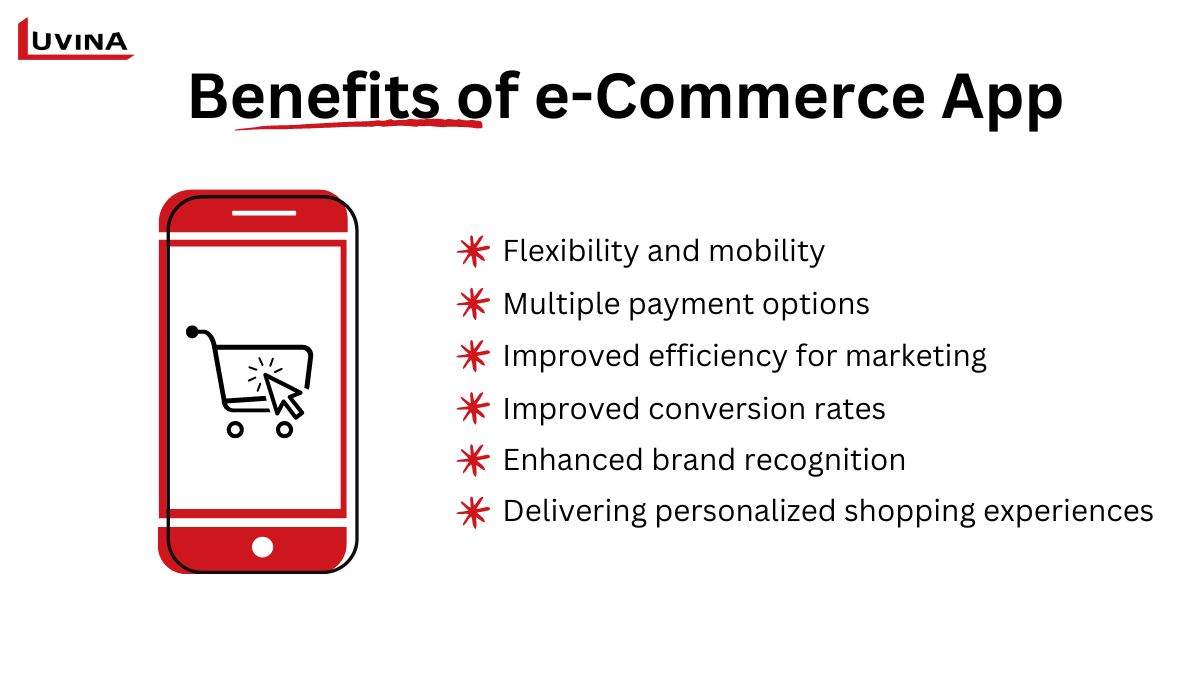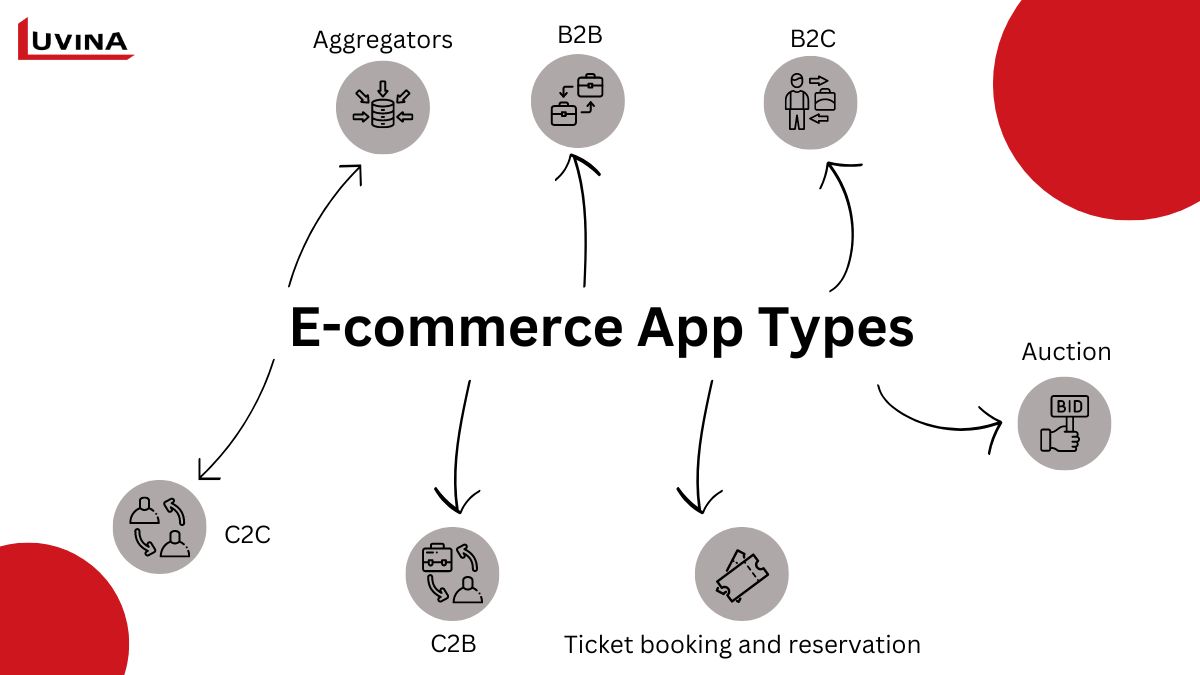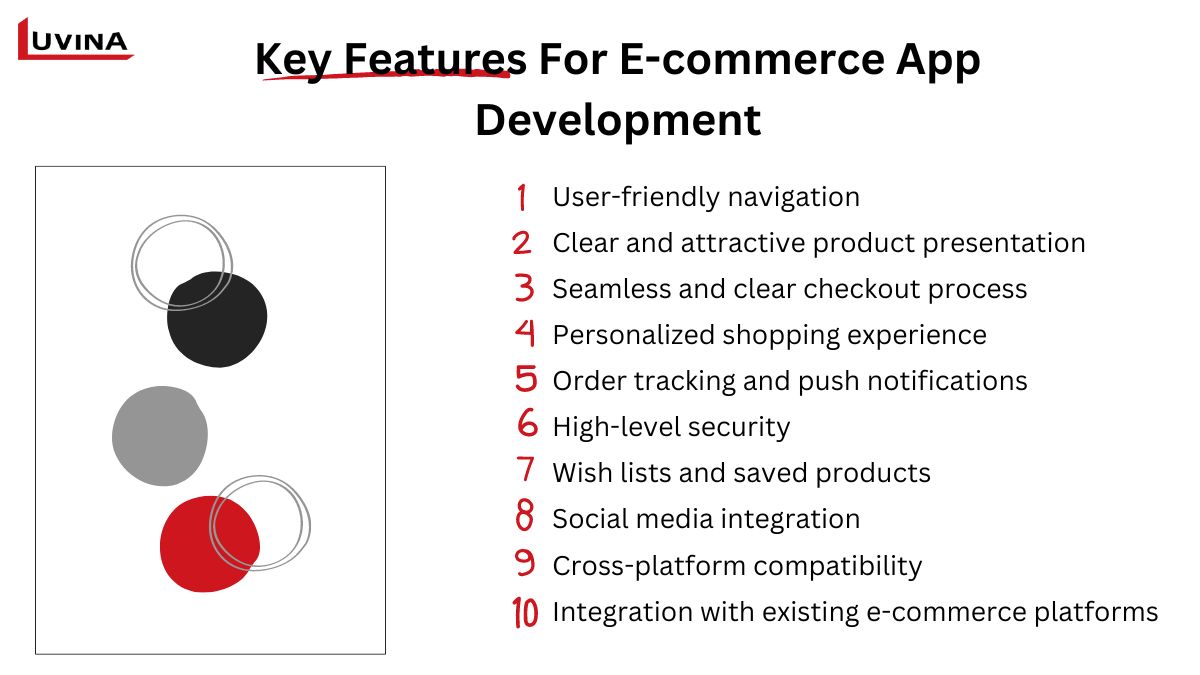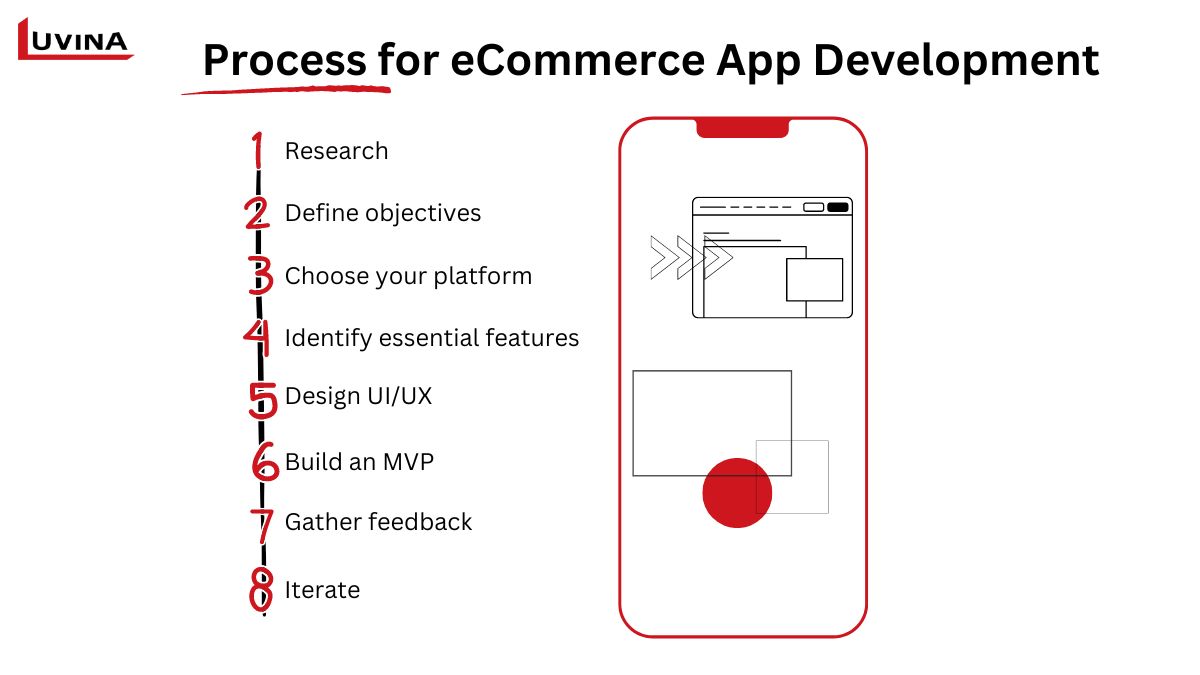These days, purchasing using e-commerce applications is the most popular shopping trend. Let’s say companies wish to draw clients and obtain a competitive advantage in the industry. If so, they ought to be conscious of how crucial it is to comprehend e-commerce app development in order to join this multi-trillion-dollar industry.
We’ll cover all you need to know in the article below to assist your company in creating an e-commerce app, from what an e-commerce app is to what features, prices and tech stack are required, to the in-depth development process. Continue reading to learn more.
What is an E-commerce Application?
An e-commerce application is a digital system used to manage and conduct the buying and selling of products or services over the Internet. E-commerce apps are typically mobile applications for iOS or Android operating systems; they can also be web applications (e-commerce platforms). Compared to e-commerce Android app development, iOS app development is currently more favored.

With the ability to drive higher conversions and attract more loyal customers, e-commerce app development is one of the strongest trends in the market, bringing significant success to online businesses.
Benefits of eCommerce App
9 out of 10 customers prefer using e-commerce apps to purchase products or services from the internet. Therefore, e-commerce app development plays a crucial role in helping businesses improve their operations. If you still need to find a reason for e-commerce mobile app development, you might change your mind after learning about the following benefits.

1. Flexibility and mobility
With an e-commerce app, you can reach various customers and introduce every item to different users, regardless of your size or location. In other words, e-commerce app development provides you with unlimited mobility.
2. Multiple payment options
To make payments on e-commerce apps, customers can use third-party payment applications like Google Pay or Apple Pay. Additionally, they can pay with regular debit cards, e-wallets, or online payment methods like PayPal. Notably, payment details can also be saved to the customer’s account, so they don’t need to re-enter their information for future purchases.
3. Improved efficiency in marketing
Most modern users today use mobile phones. Therefore, e-commerce app development can attract more customers to your business. Additionally, e-commerce apps can help businesses easily reach all customers and target specific customer segments. Businesses can also leverage analytics tools to win customers’ favor and maintain connections with loyal customers.
4. Improved conversion rates
Compared to mobile websites, e-commerce application development has been proven to deliver higher conversion rates due to its convenience and user-friendly interface. Through e-commerce apps, customers can make purchases with just a few clicks and enjoy a seamless shopping experience.
Additionally, features offered by e-commerce apps, such as push notifications, filters, and wish lists, contribute to this seamless experience. Particularly, all customer information and payment details are saved, streamlining the purchasing journey and making online shopping more convenient.
5. Enhanced brand recognition
E-commerce apps will be frequently present on users’ smartphones. So, whenever they open their phones and see your app’s logo, they will immediately recall your brand. To build positive brand recognition, you need e-commerce app development that provides a seamless user experience with a friendly design, ensuring that customers want to continue using your app.
6. Delivering personalized shopping experiences
A survey revealed that 91% of consumers prefer shopping with brands that can offer deals and suggestions tailored to them. Therefore, you need e-commerce app development that can create personalized shopping experiences.
To achieve this, you need to gather detailed and valuable information about your target customers and understand how they interact with your brand and online store. With this deep understanding, you can personalize the shopping experience for customers with product recommendations based on their purchase history, preferences, and more. Personalization is the key to building stronger relationships with customers.
>> See more: AI Personalization Ecommerce
E-commerce App Types
Before e-commerce app development, it’s essential to understand the different types of e-commerce apps to develop a sustainable business model. Here are the most commonly used types of e-commerce apps by successful businesses worldwide:

- Aggregator e-commerce app: This type of app connects end users with service providers. This model doesn’t require businesses to have the infrastructure and usually includes various types of apps such as delivery, food ordering and delivery, and packaging.
- B2B e-commerce app development: These are e-commerce apps between businesses aimed at exchanging products or goods in large quantities among enterprises. The products sold on B2B e-commerce apps are typically raw materials for other industries, such as machinery parts, and automotive parts. Alibaba is a prime example of a B2B e-commerce app.
- B2C e-commerce apps: These are among the most popular types of e-commerce apps, used by businesses to provide a product or service to individual buyers.
- C2C e-commerce apps: These are e-commerce apps for trading and transactions between at least two customers. This type of app allows individuals to offer personal items for sale. Two prime examples of C2C e-commerce apps are eBay and Amazon.
- C2B e-commerce mobile app development: Through this type of e-commerce app, experts can offer their expertise to organizations. A prime example of a C2B app is Upwork, Freelancer, and other job platforms.
- Ticket booking and reservation apps: Through these e-commerce apps on mobile devices, you can book tickets for movies, concerts, travel, and more.
- E-commerce auction apps: Recently, auction and bidding e-commerce mobile app development has become a trend. These apps help reduce the costs of traditional auction venues. eBay is a prime example of an online auction and bidding app.
>> See more: Custom Loyalty App Development Service
Key Features for E-commerce App Development
In an era when consumers expect seamless and convenient shopping experiences, e-commerce app development must ensure the following essential features to capture market attention:

- User-friendly navigation: Navigation in your e-commerce app needs to be intuitive, allowing users to quickly find the products they want and complete their purchases easily. To achieve user-friendly navigation, organize products into clear categories and integrate advanced search and filtering options.
- Clear and attractive product presentation: High-quality images and videos attract users’ attention. Therefore, when developing an e-commerce app, ensure you provide users with different views of each product, allow them to zoom in on details, and understand the item through features like 360-degree product views and high-resolution videos.
- Seamless and clear checkout process: In e-commerce app development, ensure that users can complete their purchases quickly and securely. To achieve this, integrate multiple payment options, including ones for customers who do not wish to create an account.
- Personalized shopping experience: Leverage user data to customize the shopping experience and increase user engagement with the app. Personalizing the shopping experience can involve recommending products based on browsing history and previous purchases, offering tailored deals and discounts, or integrating features like wish lists and favorite product saves.
- Order tracking and push notifications: Keep customers informed about their order status throughout the purchasing journey by combining order tracking with push notifications. Use push notifications to inform users about order confirmations, shipping updates, and delivery tracking.
- High-level security: Ensure that your e-commerce app prioritizes user safety with robust security features such as secure payment gateways, user authentication measures, and regular security updates.
- Wish lists and saved products: This feature allows users to revisit products they were interested in. Reviewing these products helps users consider and purchase them more easily in the future.
- Social media integration: Social media has immense power. During e-commerce app development, integrate social sharing buttons so users can share their favorite products with friends and family. This feature also aids in marketing and attracting new customers.
- Cross-platform compatibility: Your e-commerce app shouldn’t be limited to just one platform. During e-commerce application development, consider both e-commerce Android app development and iOS development to reach a broader user base.
- Integration with payment gateway and e-commerce platforms: Ensure that the app can seamlessly integrate with your current e-commerce platform during e-commerce mobile app development. This integration synchronizes inventory data, orders, and customer information.
>> Also read: Building A Custom Order Management System
Process for E-commerce App Development
E-commerce app development is a process that requires meticulous and detailed planning. Generally, this process involves the following 8 steps:

Step 1 – Research
Research is the first and crucial step in the e-commerce app development process. Activities include competitor analysis and user research. This step is essential to analyze user behavior and target demographics, helping you identify the most suitable features for your app.
Step 2 – Define objectives
To define your objectives, answer the following questions: What problem is your app trying to solve? Who is your target audience? What does success look like for your app? Defining objectives helps you create a development plan with an appropriate timeline and budget.
Step 3: Choose your platform
Determine whether you want e-commerce Android app development, iOS e-commerce app development, or both. This decision will also influence the corresponding tech stack required to turn your e-commerce app idea into a successful product.
Step 4 – Identify essential features
With user feedback, expert opinions, and a clear understanding of your business needs, you can now identify the key features your app must have to solve user problems and meet their expectations.
Step 5 – Design UI/UX
UI/UX design will help create an online shopping experience on your e-commerce app that surpasses offline shopping. Additionally, UI/UX design reflects your brand identity and leaves a lasting impression on your target customers. During e-commerce app development, ensure your UI/UX design includes attractive color schemes, engaging visuals, and smooth transitions.
Step 6 – Build an MVP
At this stage, create a Minimum Viable Product (MVP) with the most critical features you want in your app. Instead of a full-fledged mobile app development for e-commerce, an MVP allows you to gather user feedback, refine your app, reduce development time, and minimize risks.
Step 7 – Gather feedback
After releasing the MVP, collect customer feedback and make necessary improvements. This process helps you understand what works well for your target users and what needs adjustments.
Step 8 – Iterate
The final yet crucial step in e-commerce app development is iteration. Continuous iteration allows your app to evolve, adapt to market demands, and meet user needs consistently.
>> Also read: Unlock Sales with PWA Development for E-commerce
E-commerce app development Cost
Understanding the cost of e-commerce app development will help you estimate the budget and plan expenses effectively. However, it is challenging to determine the exact cost of e-commerce mobile app development, as the specific cost depends on many factors such as the number of features, platform, complexity of UI/UX design, and more.
Additionally, the cost of mobile app development for e-commerce also depends on the location of the software development company you choose. For example, if you choose an e-commerce development company, you may need to pay a minimum of $150 per hour. In Western Europe, the rate can range from $50 to $100 per hour, while in Eastern Europe, it is typically between $35 and $60 per hour.
According to surveys, e-commerce app development can cost a business between $80,000 and $150,000, or even more. Overall, it is difficult to predict the exact cost of developing an e-commerce app. To get an accurate estimate, you should send your ideas to app development companies for a detailed quote.
Tech Stack Needs to Develop an E-commerce Application
The tech stack is a crucial element to consider during e-commerce application development. It is a combination of tools, frameworks, platforms, and programming languages, typically determined after selecting the development platform. By effectively combining these technologies, you can develop high-quality e-commerce applications.
To create a fully functional e-commerce app, you need a tech stack that includes both front-end and back-end technologies. Below is a detailed list of these technologies:
| Technologies | |
| Front-end | HTML5/CSS3 |
| JavaScript | |
| Vue.js | |
| Bootstrap | |
| Node.js | |
| Angular | |
| React.js | |
| Flutter | |
| Back-end | C# Programming Language |
| Storage | |
| Databases | |
| Ruby [Ruby on Rails] | |
| Scala [Play] | |
| Java [Spring] | |
| MongoDB | |
| Python [Django, Pylons, Flask] | |
| Spring | |
| Groovy on Grails | |
| Web Server | |
| Laravel (PHP) | |
| PostgreSQL | |
| Firebase |
E-commerce App Development Trends
E-commerce app development is evolving day by day and will continue to do so. According to predictions, some trends below will increasingly be widely used to provide a better customer experience:
1. Big data
With the rapid increase in the number of users, big data algorithms are becoming more valuable in e-commerce application development. For example, Amazon tracks user journeys on its app and uses big data algorithms to predict what you might want to buy next and introduce products you might like.
2. Augmented reality (AR) enhanced experience
AR will bridge the gap between online shopping and shopping in physical stores. IKEA’s app is the most successful example of developing an AR-enhanced e-commerce app.
3. One-click purchase
Customers increasingly prefer the convenience of one-click payments when buying through e-commerce apps. After each purchase, the customer’s payment information is stored so they don’t have to re-enter it on their next purchase. One-click purchasing encourages customers to buy more.
4. AI Chatbots
AI in contact centers are tools for communicating and maintaining contact with customers. In specific business cases, companies can train chatbots to provide highly personalized user experiences.
5. Social commerce
Businesses will integrate their online products into social media platforms so users can buy products while browsing social media apps. Social commerce helps users easily track price changes and buy products at the right time.
>> Also read: AI in E-Commerce: Revolutionizing the Shopping Experience
Final Thoughts
The online shopping trend among customers has led to a boom in e-commerce application development. Owning an e-commerce app will bring many opportunities to your business, increasing the ability to quickly reach users to boost sales and build strong relationships with loyal customers.
Are you planning for an e-commerce app development? All you need to do is contact Luvina and let us know about your idea. With over 20 years of experience supporting numerous e-commerce businesses of all sizes, we know how to create creative, custom solutions tailored to the needs of each business. Contact Luvina today for a detailed consultation.
To learn more about the e-commerce industry, check out these additional resources:









Read More From Us?
Sign up for our newsletter
Read More From Us?
Sign up for our newsletter